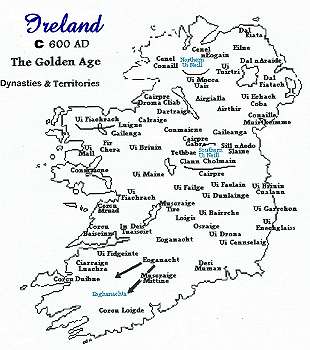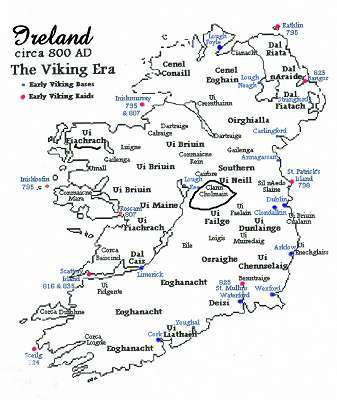Genealogy Menu
|
Uí Fiachrach Dynasty
Connacht |
Southern Uí Néill Dynasty
Midhe and Brega |
 |
 |
|
The Southern Ui Neill, represented in particular by Clann Cholmain and Sil Áeda Sláine, established dominance in northern Leinster province with their new territories on the plains of Meath/Westmeath (Midhe and Brega). They were the leading dynasties in the "middle kingdoms" of Midhe and Brega from the 5th century up to the arrival of the Normans in the 12th century. Prior to the arrival of the sons of Niall of the Nine Hostages in the 5th century, the areas of Mide and Brega were ruled under dynasties which included the Laigin, as the area has been speculated to be previously a part of the kingdom of ancient Leinster. The sons and grandsons of Niall who conquered territory in this area included Lóegaire, of Cenel Lóigaire; Conall Cremthann, ancestor of Clann Cholmáin (Mide)and of the Clann Cholmáin* line of high-kings of Ireland in the 8th through the 10th centuries, and (Brega). |
|
|
Excerpts from the Annals |
|
|
In Connacht, the Ui Briuin and Ui Fiachrach became dominant. By the 780's the Ui Briuin had consolidated their power to become the natural heirs to the kingship of Connacht. The Eoghanachta dynasties continue to alternate as kings of Munster, while the 'In Deis Tuaiscirt' (Dal Cais) begin to establish influence in parts of Tipperary and Limerick. The powerful Northern Ui Neill of Ulster and Southern Ui Neill of Midhe (Meath/Westmeath) vie for the title of Ard Ri and continue to alternate as high-kings of Ireland. In Leinster the Ui Dunlainge dynasties of the north continue their dominance of the provincial kingship, while the Ui Chennselaig of the south dominate the political scene there. Early sources suggest that a king who held the title "Rí Temro" (king of Tara) was often held in greater respect above the other kings and lords on the island. It has been said that Ollam Fodla first gave historic fame to Tara by founding the Feis (or Triennial Parliament) there, seven or eight centuries before Christ. |
|
|
Excerpts from the Annals |
|
|
758 AD - After Domhnall, son of Murchadh, son of Diarmaid, had been twenty years in sovereignty over Ireland, he died. He was the first king of Ireland of the Clann Colmain, and he was buried at Dearmhagh (Durrow) with honour and veneration. He was succeeded by Niall Frosach, son of Fearghal, in sovereignty over Ireland. |
|
|
Uí Fiachrach had two main branches, one in the north of Connacht, the Uí Fiachrach Mauide, and the other in the south, the Uí Fiachrach Aidne, which also dominated much of north Munster in the seventh century. Much of Counties Mayo and Sligo was ruled by the Uí Fiachrach Mauide up to the 13th century, shared by the influential Ua Maile and Gailenga clans. At its widest reach, this territory included what were later to be known as the baronies of Erris and Tirawley in County Mayo and Tireragh in County Sligo. |
|
 |
 |
|
As we have already seen, the personal name Colmáin was very popular in ancient Ireland. It was adopted as a clan and sept name by cousins of Columcille in both the Southern Ui Neill and Uí Fiachrach dynasties. While Clann Cholmáin was an important part of the Southern Ui Neill and while it is possible that a number of these Colmáin(s) gave rise to different Ó Colmáin families, the only recorded family of the surname were a branch or sept of the Uí Fiachrach Mauide in north Connacht. This sept were chiefs or princes of Tireragh until the arrival of the Anglo-Norman families in this area in the early thirteenth century. The sept had its ancient headquarters in the townland of Grangemore*, parish of Templeboy, County Sligo. Columhán of this sept was the 10th Christian King of Connacht, and ancestor of the Colmáin (Coleman) families. |
|
|
The Annals cite: |
|
 |
|
|
*Extract from John O'Hart's Irish Pedegrees Part vii, 571 |
|
|
To correct a view shared by some of those people interested in the origin of the anglicised surname Coleman, where they believe its derivation to be occupational, I will refer to A Dictionary of British Surnames, London and Boston 1976, by P.H. Reaney Litt.d., Ph.D., F.S.A., one of the foremost authorities on English surnames. In page 79, the full entry for Coleman, with abbreviations expanded, reads:"Coleman, Colman, Collman, Coulman: Coleman 1066 Domesday Book; Colemannus de Eston 1176 Pipe Rolls (Buckinghamshire); Hervicus, Richard Coleman 1166 Red Book of the Exchequer (Rolls Series 99, 3vols, 1896)(Yorkshire, 1176 Pipe Rolls (Surrey). The surname is early, frequent and widely distributed. In the north is usually from Old Irish Colmán, earlier Columbán, adopted by Scandinavians as Old Norse Kalman, and introduced from Ireland into Cumberland, Westmoreland and Yorkshire by Norwegians from Ireland. In Domesday Book the personal name is southern and south eastern and is probably Old German Col(e)man. In the Sussex Subsidy Rolls, where both Coleman and Collier are frequent surnames, both probably mean 'charcoal-burner'".(1) |
|
|
1. Members of one of these English Coleman families came to Ireland during the Anglo-Norman invasion in 1169 AD and settled in Dublin. They left descendants who settled in a few locations in the province of Leinster.* A few other Colemans of English origin settled in Ireland at different times since then, but their descendants are not very numerous today. |
|
|
Long before the Vikings from the various Scandinavian countries turned their attention to Ireland or England, the Irish monks had, as Thomas Cahill states in his book, "launched a spiritual invasion of England from their monastery of Lindisfarne in the northeast corner of Northumbria, establishing new monasteries in brisk succession. On account of this activity, Aiden, Columcille's beloved desciple and first abbot of Lindisfarne, has far better claim than Augustine of Canterbury to the title Apostle of England, for, as the Scottish historian James Bullock has remarked, 'All England north of the Thames was indebted to the Celtic mission for its conversion'. Nor was Lindisfarne the only launching pad for the Irish monks: they were on good terms with the British Celts and began to set up bases in the western territories as well." |
|
|
The adoption of Columbán (Colmán) as a religious name, owing to the popularity of the two Columbas, was no less popular in England north of the Thames than in Ireland. Given the widespread use of Coleman, Colman, Collman, Coulman in England long before the derivation of names from occupations, it is only reasonable to conclude that the name Coleman in the Sussex region was not derived from 'charcoal-burner'. As the name was already popular, there was no need for such a development. Indeed the reference in the extract from A Dictionary of British Surnames to the Old German Col(e)man fails to make the link with Columbanus's (Columbán) popularity in mainland Europe which would explain its origin. One has only to look at one of the decisions of the Synod of Whitby (Abbey in Northumbria) in 664 where the differences between the traditions of Celtic Christianity and those of the stricter Roman Christianity of St Augustine's Canterbury were thrashed out, Augustine having introduced Roman Christianity to southern England in 597 AD. The Irish party was led by Colmán, abbot of Lindisfarne. The main issue was the correct date for celebrating Easter. The Roman party viewed the Irish calculation, which differed from the Roman by a few days, as tantamount to heresy. The king ruled in favour of the Roman party, but the person responsible for bringing the Irish party over to the Roman observance was the Irish abbot, Cummian. The Irish party agreed, however reluctantly, "that their father in God, Columcille, whose name was invoked in all their customs, took second place to Peter, the prince of the Lord's apostles, in whose name the Roman party made its argument." (Cahill.) This last statement demonstrates further the great influence and importance of this Irishman, and its easy to see why the Irish name Colmán would be so popular in Christian England long before any Viking influence. Furthermore, Colmán, a native of north Connacht and member of Uí Fiachrach Mauide, who as bishop-abbot of Lindisfarne led the Irish party at the Synod of Whitby, had a large number of Saxon monks retire to Iona with him in protest at the outcome of the synod. A short later, he returned to Ireland with his Saxon monks and founded a monastery at "Magh Eó" (Plain of Yew Trees) not far from his birthplace in north Connacht. The importance and size of Mayo (Magh Eó) Abbey* as it was later called is recorded in many chronicles of that period, the most important being the Ecclesiastical History of the English People, written by The Venerable Bede of Jarrow and The Annals of Ulster. |
|
 Clan Coleman
Clan Coleman